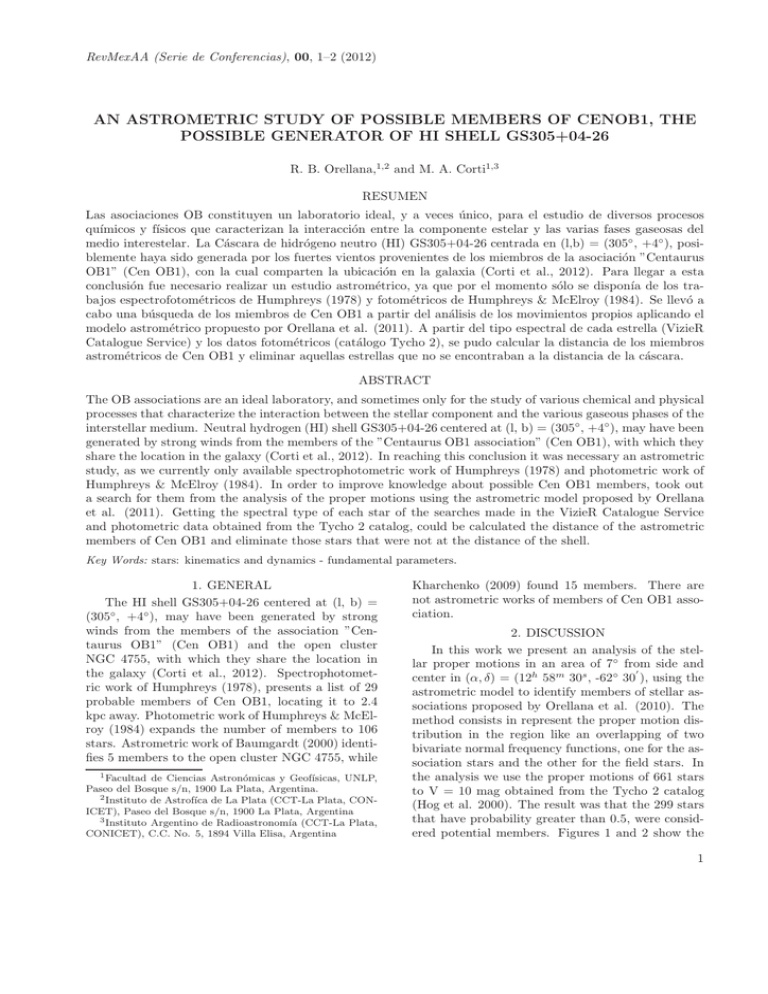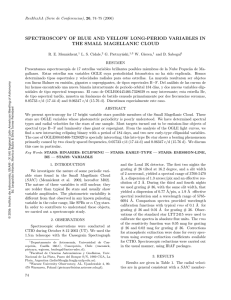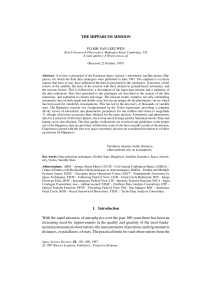AN ASTROMETRIC STUDY OF POSSIBLE MEMBERS OF CENOB1
Anuncio

RevMexAA (Serie de Conferencias), 00, 1–2 (2012)
AN ASTROMETRIC STUDY OF POSSIBLE MEMBERS OF CENOB1, THE
POSSIBLE GENERATOR OF HI SHELL GS305+04-26
R. B. Orellana,1,2 and M. A. Corti1,3
RESUMEN
Las asociaciones OB constituyen un laboratorio ideal, y a veces único, para el estudio de diversos procesos
quı́micos y fı́sicos que caracterizan la interacción entre la componente estelar y las varias fases gaseosas del
medio interestelar. La Cáscara de hidrógeno neutro (HI) GS305+04-26 centrada en (l,b) = (305◦ , +4◦ ), posiblemente haya sido generada por los fuertes vientos provenientes de los miembros de la asociación ”Centaurus
OB1” (Cen OB1), con la cual comparten la ubicación en la galaxia (Corti et al., 2012). Para llegar a esta
conclusión fue necesario realizar un estudio astrométrico, ya que por el momento sólo se disponı́a de los trabajos espectrofotométricos de Humphreys (1978) y fotométricos de Humphreys & McElroy (1984). Se llevó a
cabo una búsqueda de los miembros de Cen OB1 a partir del análisis de los movimientos propios aplicando el
modelo astrométrico propuesto por Orellana et al. (2011). A partir del tipo espectral de cada estrella (VizieR
Catalogue Service) y los datos fotométricos (catálogo Tycho 2), se pudo calcular la distancia de los miembros
astrométricos de Cen OB1 y eliminar aquellas estrellas que no se encontraban a la distancia de la cáscara.
ABSTRACT
The OB associations are an ideal laboratory, and sometimes only for the study of various chemical and physical
processes that characterize the interaction between the stellar component and the various gaseous phases of the
interstellar medium. Neutral hydrogen (HI) shell GS305+04-26 centered at (l, b) = (305◦ , +4◦ ), may have been
generated by strong winds from the members of the ”Centaurus OB1 association” (Cen OB1), with which they
share the location in the galaxy (Corti et al., 2012). In reaching this conclusion it was necessary an astrometric
study, as we currently only available spectrophotometric work of Humphreys (1978) and photometric work of
Humphreys & McElroy (1984). In order to improve knowledge about possible Cen OB1 members, took out
a search for them from the analysis of the proper motions using the astrometric model proposed by Orellana
et al. (2011). Getting the spectral type of each star of the searches made in the VizieR Catalogue Service
and photometric data obtained from the Tycho 2 catalog, could be calculated the distance of the astrometric
members of Cen OB1 and eliminate those stars that were not at the distance of the shell.
Key Words: stars: kinematics and dynamics - fundamental parameters.
1. GENERAL
The HI shell GS305+04-26 centered at (l, b) =
(305◦ , +4◦ ), may have been generated by strong
winds from the members of the association ”Centaurus OB1” (Cen OB1) and the open cluster
NGC 4755, with which they share the location in
the galaxy (Corti et al., 2012). Spectrophotometric work of Humphreys (1978), presents a list of 29
probable members of Cen OB1, locating it to 2.4
kpc away. Photometric work of Humphreys & McElroy (1984) expands the number of members to 106
stars. Astrometric work of Baumgardt (2000) identifies 5 members to the open cluster NGC 4755, while
1 Facultad de Ciencias Astronómicas y Geofı́sicas, UNLP,
Paseo del Bosque s/n, 1900 La Plata, Argentina.
2 Instituto de Astrofı́ca de La Plata (CCT-La Plata, CONICET), Paseo del Bosque s/n, 1900 La Plata, Argentina
3 Instituto Argentino de Radioastronomı́a (CCT-La Plata,
CONICET), C.C. No. 5, 1894 Villa Elisa, Argentina
Kharchenko (2009) found 15 members. There are
not astrometric works of members of Cen OB1 association.
2. DISCUSSION
In this work we present an analysis of the stellar proper motions in an area of 7◦ from side and
′
center in (α, δ) = (12h 58m 30s , -62◦ 30 ), using the
astrometric model to identify members of stellar associations proposed by Orellana et al. (2010). The
method consists in represent the proper motion distribution in the region like an overlapping of two
bivariate normal frequency functions, one for the association stars and the other for the field stars. In
the analysis we use the proper motions of 661 stars
to V = 10 mag obtained from the Tycho 2 catalog
(Hog et al. 2000). The result was that the 299 stars
that have probability greater than 0.5, were considered potential members. Figures 1 and 2 show the
1
ORELLANA & CORTI
-67
-66
-65
δ [deg]
{/Symbol d}[deg]
-64
-63
-62
-61
-60
-59
-58
186
188
190
192
194
196
{/Symbol a}[deg]
198
200
202
204
α [deg]
Fig. 1.
Tycho2 stellar positions in the region of
Cen OB1. The squares represent the astrometric members of Cen OB1 (299 stars) and the asterisks the rest of
the stars in the region.
10
8
6
4
[mas/yr
location of the 299 association members in the sky
and in the VPD with different symbols.
To remove the stars that have the same value
of proper motion of the association but do not belong to it, we calculate the distances from the photometric and spectroscopic data using the equation
”distance modulus” (Schmidt-Kaler, Th 1982). The
spectral type of stars identified as astrometric members was obtained from Simbad4 of the ”VizieR Catalogue Service” and the intrinsic photometric data
such as (B-V)o colour index, absolute visual magnitude Mv and visual extinction Av = 3.1*E(B-V),
where E(B-V) is the stellar colour excess, from the
Schmidt-Kaler, T. (1982). The V and B photometric
magnitudes of these stars were obtained from the astrometric catalog Tycho 2 and converted to Johnson
photometric systems (Besell & Brest, 1988).
Spectral type was obtained for only 284 stars of
the 299 identified astrometrically, then we calculate
the distance modulus for them. Figure 3 shows the
distribution obtained for the 284 stars and is possible
to see two peaks corresponding to distance modulus
= 9.6 mg and 12.4 mg, respectively. The first peak
correspond to distance of 0.8 kpc and the second to
distance of 2.6 kpc, that would indicate the probable
Cen OB1 distance coincident with the shell. These
results allow us to reduce the sample and improve
the identification of members of Cen OB1.
2
0
µδ
2
-2
-4
-6
Acknowledgements. This work was partially supported by Consejo Nacional de Investigaciones
Cientı́ficas y Técnicas CONICET under projects PIP
01299 and 01359 and by Universidad Nacional de La
Plata (UNLP) under projects G091 and G096.
REFERENCES
Baumgardt, H., Dettbarn, C. & Wielen, R. 2000, A&AS,
146, 251.
Bessell, M.S. & Brett, J.M. 1988, PASP, 100, 1134.
Corti, M.A., Arnal, E.M. & Orellana, R.B. 2012,
arXiv1207.4829.
Hog, E+ 2000a, A&A, 355, L27.
Humphreys, R.M. 1978, ApJS, 38, 309.
Kharchenko+ 2009, A&A, 495, 807.
Orellana, R.B., De Biasi, M.S., Bustos Fierro, I.H. &
Calderón, J.H. 2010, A&A, 521, 3900.
Schmidt-Kaler Th. 1982, In Landolt-Bornstein New Series, Group VI, Vol. 2b (eds. K. Schaifers & H.H.
Voigt), (Springer-Verlag, Berlin).
Walborn, N.R. 1972, AJ, 77, 312.
-8
-10
-20
-15
-10
-5
µα cosδ
0
[mas/yr]
[
5
10
Fig. 2. VPD of the same region as Figure 1. The symbols
represent the same as Figure 1.
Distance modulus
Fig. 3. Distribution of the distance modulus of OB stars
in the region of Cen OB1.
4 SIMBAD
database, operated at CDS, Strasbourg, France.



